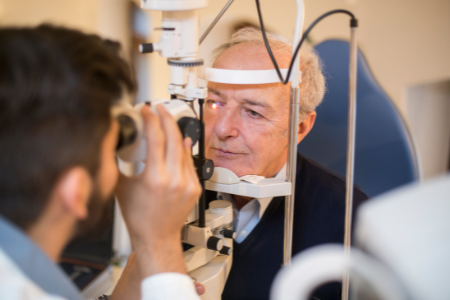 What is glaucoma and how does it develop?
What is glaucoma and how does it develop?- Do we know the cause of glaucoma?
- What are the types of glaucoma?
- What are the symptoms of glaucoma?
- Can glaucoma be cured?
- Can I prevent glaucoma?
Glaucoma is a disease of the eye’s optic nerve, a critical component that allows you to see. If left untreated, glaucoma can cause blindness. It’s a silent disease in that, although three million people in the U.S. have glaucoma, many don’t even realize it.
What are the glaucoma symptoms to watch for? Is there anything you can do to prevent the disease? How is glaucoma treated? Let’s go over the answers to these questions.
What Is Glaucoma and How Does It Develop?
Glaucoma is a type of degenerative eye disorder. There are several different forms of the disease and all can be treated. However, in the early stages of the disease, there are often no symptoms. That’s why it’s so important to have your eyes tested regularly. If the glaucoma is undetected, it will damage your eyes and lead eventually to blindness.
To understand glaucoma, you should know a little about how the eye works. At the front of the eye is the cornea, a clear lens that covers the pupil and iris of the eye. Light hits the clear lens and travels to the back of the eye where the optic nerve connects to the brain.
The eye itself is filled with a clear fluid called aqueous humor. This fluid constantly bathes the eye every time you blink. Excess liquid flows out the bottom of the eye’s drainage system called the trabecular meshwork, and it’s when this meshwork gets clogged that glaucoma can develop. Over time, this problem of building pressure in the eye can cause enough damage that it leads to blindness.
Do We Know the Cause of Glaucoma?
We know the cause of glaucoma stems from the eyes inability to regulate pressure via the natural system of aqueous humor production and drainage. Without the ability to maintain proper eye pressure, it will increase and put pressure on the optic nerve. Eventually, damage can occur that causes vision loss and eventual blindness.
There are also some medical conditions that can increase the eye’s pressure, such as diabetes, heart disease, hypertension, or sickle cell anemia. Technically speaking, everyone is at risk for glaucoma; however, there are a few characteristics that could increase your chances of developing the disease. These risk factors are:
- If you are over 60 years old
- If you are of Asian, African, or Hispanic descent
- If you are a frequent user of steroid medications
- If glaucoma runs in your family
- If you are very far-sighted or very nearsighted
Some people are more at risk simply because their eye pressure tends to run higher than normal. Even people that have a thin central cornea in their eye may be more at risk for glaucoma later on.
What Are the Types of Glaucoma?
 There are several types of glaucoma, some of which present with symptoms and others that can sneak up on you. They include:
There are several types of glaucoma, some of which present with symptoms and others that can sneak up on you. They include:
- Open-angle glaucoma. This is the most common variation, occurring in about 90% of all cases.
- Angle-closure glaucoma. This happens when the angle between the iris and cornea closes off and increases eye pressure.
- Normal-tension glaucoma. This rarer type of glaucoma can happen even when the eye’s pressure isn’t elevated.
- Childhood glaucoma. Sometimes glaucoma can be present from birth.
- Pigmentary glaucoma. This variation causes tiny granules from your iris to build up and block the eye’s drainage channels
There is also exfoliative glaucoma, neovascular glaucoma, glaucoma caused by an eye injury, and more. Because there are so many varieties, glaucoma can be difficult to detect from symptoms alone.
What Are the Symptoms of Glaucoma?
If you’re suffering from open-angle glaucoma, the disease can sneak up on you without any symptoms. This creates more risk that you’ll experience serious damage to the eye before you even realize you’re sick. Your eye doctor can check your peripheral (side) vision as well as your eye pressures as a proactive way to determine if you’re developing glaucoma. Without an eye exam, you may not know until it’s too late.
Angle-closure glaucoma can escalate quickly so there are more obvious signs that something is wrong:
- A severe headache
- Blurring vision
- Pain in one or both eyes
- Seeing “light halos”
- Very red or hazy-looking eyes
- Vision loss
- Vomiting or an upset stomach
If you have these symptoms, it’s important to see a doctor as soon as possible.
Can Glaucoma Be Cured?
Glaucoma can’t be cured, but it can be managed quite well. Your doctor may prescribe eye drops or oral medications to control the progression of the disease. In some cases, surgery may be necessary.
Eye drops can help decrease the amount of fluid in your eye. Your doctor may put you on more than one type of eye drop to achieve different goals in controlling the disease.
Oral medications can slow down fluid production in the eye or work to help improve drainage.
Surgery may be an option if you have open-angle or angle-closure glaucoma. The surgery can help unclog a blocked drainage system to help the eye function normally.
Can I Prevent Glaucoma?
 The best way to prevent glaucoma from turning into a big issue is to have a routine test for the disease each year at your eye exam. Glaucoma tests are fast and painless. Your eye doctor will test your vision and then use eye drops to dilate the eye and look inside at the optic nerve. You’ll also receive a test to check your eye pressure and another test to check your peripheral vision. When it comes to glaucoma, a little prevention can help you care for your eyes and stop glaucoma in its tracks.
The best way to prevent glaucoma from turning into a big issue is to have a routine test for the disease each year at your eye exam. Glaucoma tests are fast and painless. Your eye doctor will test your vision and then use eye drops to dilate the eye and look inside at the optic nerve. You’ll also receive a test to check your eye pressure and another test to check your peripheral vision. When it comes to glaucoma, a little prevention can help you care for your eyes and stop glaucoma in its tracks.
A diagnosis of glaucoma can seem overwhelming, but this chronic condition can be managed so that no additional damage to your eyes occurs.
As Miami’s leading eye doctors specializing in glaucoma, cataract, and dry eye, our team at Miami Eye Specialists can help you get the right diagnosis and treatment for your glaucoma. With low-risk, minimally invasive options to improve your sight, we look forward to helping you see without compromise once again.

